Menu

The Stone Barns Center, near New York City, is leading in sustainable agriculture. It’s just 30 minutes from downtown. They have mastered autumn cover cropping techniques. In 2017, Growing a Greener World® highlighted their work. This included a look at their methods with the famous Blue Hill restaurant.
Jack Algiere guides cover crop use at Stone Barns. For them, cover crops are a key part of sustainable farming. These crops, such as rye, oats, clover, and buckwheat, are planted after the main crops. They boost soil fertility, aeration, and structure for the next round of planting. While they may not make it to your table, they greatly help the farm. They improve soil health and help control pests without chemicals.
Autumn cover cropping is a key part of regenerative farming. It helps boost soil health and promotes sustainable agriculture. This practice not only keeps the soil safe, but it also adds important nutrients and tackles weeds. The result is a strong and fertile soil that supports healthy plant growth.
Cover crops do wonders for the soil, and they are not planted to harvest. They play a big role in sustainable farming by stopping soil erosion and making the soil better. These crops are sown in autumn, making the most of the time after other plants have been harvested. It’s very important to prepare the soil well for them so they can grow successfully.
At the Stone Barns Center, Jack Algiere supports the use of cover crops because they offer many perks. They safeguard the soil and boost nutrients, which are vital for soil health. Plants like legumes and grains enrich the soil health by adding nutrients through photosynthesis. They also fix nitrogen from the air, adding between 40 to 200 lbs. per acre. This is good for future crops and helps soil in big ways.
Autumn cover crops also keep weeds at bay by creating a barrier against them. Selecting the right seeds for sowing is key. It’s important to choose carefully to ensure an even spread of plants. For small seeds, scattering them across the ground is best on lighter soils. For tough ground, like clay, planting with a drill is more effective. Rolling the seedbed after planting helps the seeds mix well with the soil and keeps them moist, aiding their growth.
Good nitrogen management in autumn is vital too. Research, including work by Dr. Greg Hoyt, shows that about 40% of the nitrogen from a dead cover crop is used by plants in the first year. When the cover crop is turned into soil, the remaining 60% supports the next year’s growth. For example, a crop like hairy vetch can give as much as 90 lbs. of nitrogen to the next grain or vegetable crop, helping to keep the soil rich and healthy.
Cover cropping in autumn has many good points for soil and crops. It’s vital for boosting soil fertility and keeping weeds at bay. This method is gaining popularity in farming systems that aim to regenerate soil.
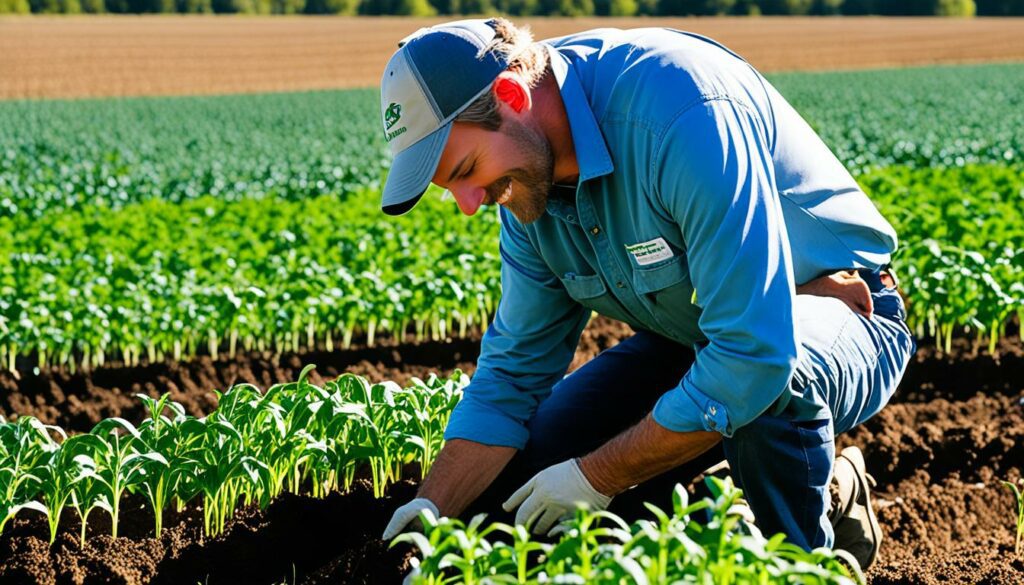
Cover crops like hairy vetch and crimson clover are great for the soil. They can give 30-60% of nitrogen needed by main crops. This cuts down on the use of artificial nitrogen. For example, Austrian winter peas could cover all the nitrogen needs for the next round of potato plants.
Root-rich grains like rye and wheat help too. They take in leftover soil nutrients after the main crop is harvested. They can collect up to 71 lb. N/A of nitrogen in three months. This keeps the soil nutritious for future plants and stops nutrients from leaking away.
Cover cropping is also very effective against weeds. Quick-growing cover crops like buckwheat form a thick layer, shading out weed growth. This means less herbicides are needed. Hairy vetch and crimson clover are good at reducing spring weeds, acting as a natural barrier.
When to cut these cover crops is key. If they are cut right before they make seeds, they’ll put more nutrients back into the ground. This timing is important for the full benefit of cover cropping. It helps make farming practices more sustainable and productive.
Cover crops reduce the need for herbicides. They manage weeds and even help fight pests. Using these crops in autumn supports farming that is good for the earth. It’s in line with the principles of regenerative agriculture.
When thinking about autumn planting, you need to look at the cover crop types. These help make the soil better and increase the amount of roots in the ground. Grains, legumes, and broadleaves all do different good things for the soil.
Grains like rye, oats, and winter wheat are very important for autumn planting. They have big roots that make the soil less hard and better. Winter rye, for example, grows roots up to 16 inches deep. This helps stop the soil from moving and getting too hard because of wind and rain. Oats can go into the soil about 6-8 inches and can be as tall as 4 feet. This adds a lot of stuff to the soil that plants like to grow in, improving the soil’s carbon content.
Legumes, such as White Clover and Crimson Clover, are great for adding to the soil. They help make the soil better by not needing as much extra stuff like fertilizers. This is because they can fix nitrogen, an important nutrient for plants, from the air. They also help to make the soil soft and airy, which is good for plants to grow well. Plants like hairy vetch and field peas are good at adding nutrients to the soil. They help make the soil more fertile and strong.
Crops like mustard and buckwheat are quick to grow and help a lot during autumn planting. Mustard grows a lot of roots quickly, stopping weeds from growing. It’s great for making the soil structure better and stopping weed problems. Buckwheat likes cool weather and brings in good insects that help other plants. It also helps put nitrogen back into the soil. Both of these plants mix well into the soil, which helps keep the nutrients moving around and brings in more roots.
Choosing the right grains, legumes, and broadleaves for autumn planting can really help the soil and make more roots grow. This makes your cover cropping work well and good for the long run.
Starting autumn cover cropping needs thinking about what crops to use, how to plant them, and how to take care of the garden. Picking the right cover crops and planting them well are key. This way, you get the most from cover crops. Now, let’s look into this further:
The right cover crops depend on what you want, like better soil, less weeds, and fewer pests. For instance, farmers in Pennsylvania often choose annual ryegrass. It’s good for the soil, stops erosion, and improves soil quality. Crops like Austrian winter pea, triticale, and hairy vetch are great for winter. They keep growing in the cold.
Buckwheat and iron clay peas are good for the warmer months. They grow fast and help add nutrients to the soil. White Dutch clover is a top pick for the spring and early summer. It cuts down on weeds and helps add nitrogen to the soil.
How you plant cover crops really matters. Direct sowing is a smart choice. It means planting seeds right into the soil after your summer plants are gone. This saves you time. In places like Philadelphia, the best time to plant these crops is between September 15 and October 15. This lets them get settled before winter.
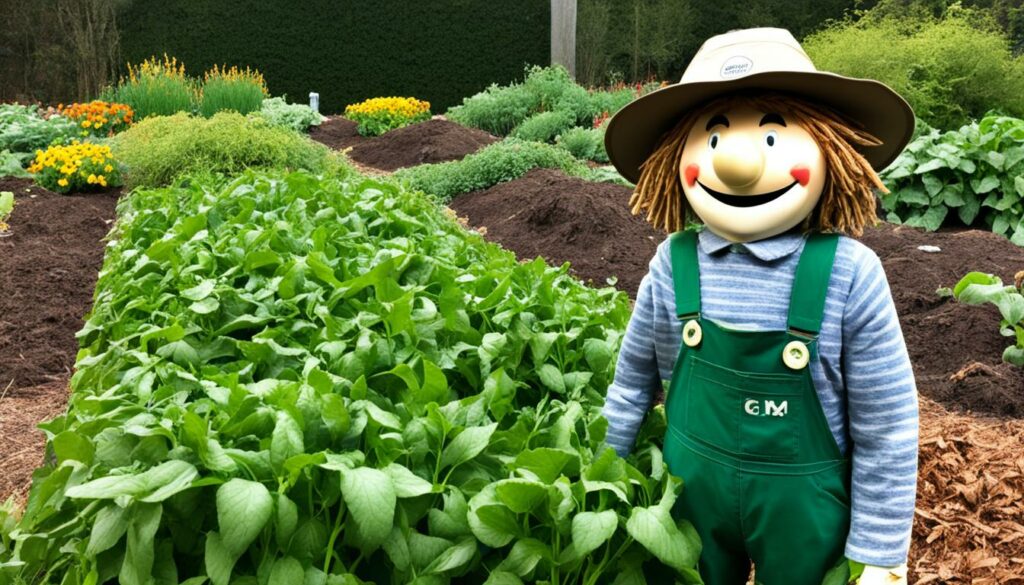
Winter rye is another good option. It can survive harsh winters and makes the soil healthier. You can mix its roots into the soil or use its leaves in compost. This helps the soil stay fertile and full of good stuff.
One more useful trick is interplanting. You can plant iron clay peas with pumpkins or mix cool-season plants with fall potatoes. This makes taking care of the garden easy while you wait for your main crops to grow.
| Cover Crop | Season | Benefits |
|---|---|---|
| Annual Ryegrass | Year-round | Soil Erosion Prevention, Soil Structure Enhancement |
| Austrian Winter Pea | Cool-season | Weed Suppression, Nitrogen Fixation |
| Buckwheat | Warm-season | Quick Growth, Soil Fertility Improvement |
| Iron Clay Peas | Warm-season | Interplanting, Pest Control |
| White Dutch Clover | Spring/Early Summer | Weed Suppression, Soil Fertility Improvement |
In conclusion, thinking carefully about which crops to use and how to plant them makes a big difference. With the right steps, your garden can stay productive, well-aerated, and easy to manage in autumn.
Autumn cover cropping is key for healthy soil and a sustainable farm. Picking the best cover crops can boost soil quality, help plants grow better, and protect the environment. I’ll talk about the top choices and what they do for your land.
Choosing the right cover crops for autumn is crucial. Here are some popular types:
These options include both annual and perennial plants. They each offer unique benefits and make for strong cover crop mixes across different climates.
All the cover crop types I’ve mentioned are great for managing nutrients and improving soil. Here’s why each one is so useful:
| Cover Crop Type | Key Benefits |
|---|---|
| Ryegrass | Predominant on Pennsylvania farms, ryegrass protects soil from erosion and reduces stormwater runoff. It also improves soil quality by forming a dense mat that helps suppress weeds. |
| Crimson Clover | A nutrient-rich plant that adds significant nitrogen to the soil, essential for subsequent crops. It is effective for weed suppression, erosion control, and attracting pollinators. |
| Hairy Vetch | Another leguminous plant that adds nitrogen to the soil, boosting fertility levels upon decomposition. It is resilient and supports soil health even in challenging conditions. |
| Daikon Radishes | Excellent for breaking up poorly drained soils, radishes should be planted in midsummer. They enhance soil structure before naturally decomposing in winter, providing vital nutrients. |
| Oats | Known for restoring soil fertility, oats capture additional soil nutrients and can be planted in spring or fall. They improve soil structure and organic matter. |
When you plant is important. In Philadelphia, it’s best to plant between September 15 and October 15 to get the most out of your crops. Planting four weeks before the first frost lets the cover crops grow well. This way, they can improve the soil for your next planting season.
Winter cover crops are essential for keeping soil healthy and fertile in the cold. I use crops like winter rye and red clover to soak up leftover nutrients in the soil. This boosts the soil’s health for the next crop.
Legumes like Austrian winter peas and NITRO alfalfa are also key. They’re good at pulling nitrogen from the air, providing most of the nitrogen needed for the next potato crop. This keeps the soil full of nutrients in spring. Hairy vetch is another great option. It helps increase crop yields while cutting costs, a win-win for winter gardening.
Winter cover crops stop soil from washing or blowing away, acting like a shield against erosion. They prevent nitrogen from leaching into water, improving water quality. This shows how they help farms stay eco-friendly and sustainable.
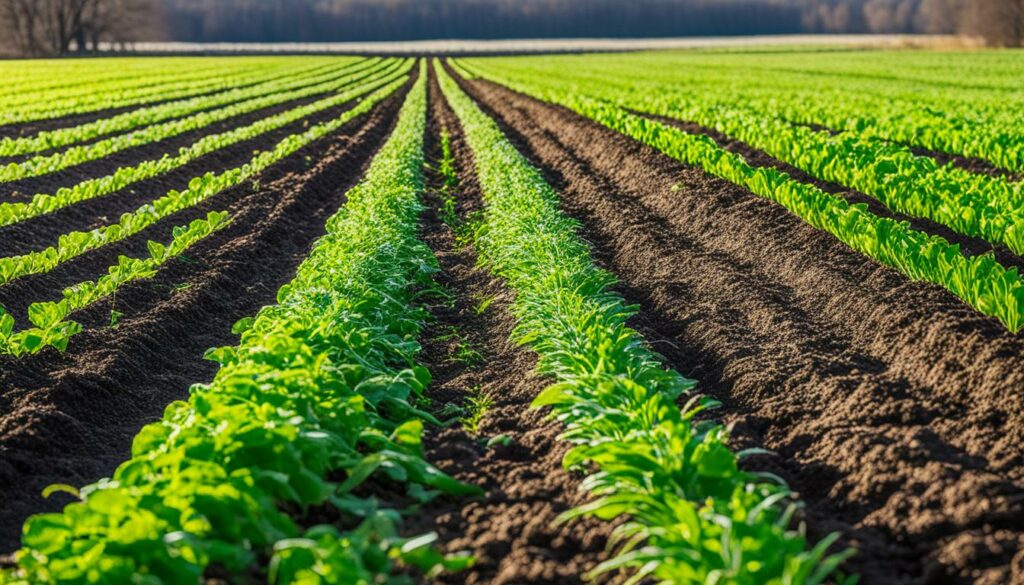
They also help with pest control, meaning fewer harmful chemicals are needed. Research in southeast Pennsylvania found that using crops like rye and vetch can cut down on pesticide use. Plus, planting some crops together, like medium red clover and hairy vetch with oats, leads to more fertile soil and bigger corn harvests.
Frost seeding is one special technique. It means planting seeds like red clover in frozen ground. When the soil thaws, the seeds are already there, ready to grow. This early start can make a big difference in the success of the growing season.
In the end, winter cover crops do a lot for the farm. They improve the soil, stop erosion, manage nutrients, and cut farming costs. They really prepare the ground for a great growing season.
Using the right techniques for autumn cover cropping is important for soil health and to lessen soil erosion. By not over-tilling and using no-till methods, our gardens can be more strong and alive. Jack Algiere at Stone Barns Center has shown this with his work.
No-till farming keeps the soil in good shape by not disturbing it too much. It keeps the soil healthy, holds more water, and helps tiny life in the soil to grow. Winter rye and other cover crops are great for this method. They add their own nitrogen, which means less need for man-made fertilizers. This way of farming also cuts down on how much soil washes away because the earth is protected by the cover crop.
“Leguminous cover crops add nitrogen to the soil, reducing the need for additional fertilizers or compost, benefiting organic, no-till, and regenerative growers.”
Mulching is another good choice, offering protection from bad weather and reducing soil erosion. By using things like straw or old leaves, we can help the soil stay full of life. This method shields the earth from the impact of the weather and feeds it with nutrients as the mulch breaks down. In colder areas, it’s perfect because the cover crops die in winter, making it easier to plant new things in spring.
To summarise the benefits of these autumn cover cropping techniques:
| Technique | Benefits | Example Crops |
|---|---|---|
| No-Till Cover Cropping | Preserves soil structure, reduces erosion, enhances moisture retention | Winter rye, legumes |
| Mulching | Protects against elements, prevents erosion, builds organic matter | Oats, barley, clover |
Autumn cover cropping plays a big part in eco-friendly agriculture by improving soil health and encouraging a variety of life. Jack Algiere at the Stone Barns Center shows how to do this. He grows different crops in autumn, like legumes and grains. This boosts the soil’s structure and adds more natural material, making the soil healthier.

Over 15 million acres were covered by crops in autumn in 2017. This is 50% more than five years ago. It shows more and more farmers are using conservation practices. Also, the amount of land used for these cover crops has doubled in many U.S. states. This proves a strong national commitment to care for the earth.
Cover crops can make corn yield 3% more and soybeans 4.9% more after five years. They were especially helpful in the drought of 2012, raising corn yield by 9.6% and soybeans by 11.6%.
| Year | Cover Crop Acres (Million) | % Increase |
|---|---|---|
| 2012 | 10.3 | – |
| 2017 | 15.4 | 50% |
Crops like clover and vetch can add up to 150 pounds of nitrogen per acre by the next planting season. Others, like rye and oats, soak up 30 to 50 pounds of nitrogen. This boosts the soil’s health by enriching it with nutrients.
Cover crops are like a shield against heavy rain and erosion. They lessen the impact of soil loss and nutrient runoff. This is very important in the Northeast of the United States, where the weather can be unpredictable.
From a financial point of view, cover crops have lots of benefits. They raise crop output, cut down on machine expenses, and reduce the need for chemicals. Even though starting with cover crops can be pricey, the long-term gains are significant.
All in all, autumn cover cropping is good for the soil, for wildlife, and for our farming future. By using these crops, we help the environment and make our farms more successful.
Autumn cover crops are key for soil health. They improve nitrogen levels, help air to move in the soil, and add to the organic matter. By carefully choosing and caring for these crops, I can boost the health and output of the soil in my organic farming.
Plants like hairy vetch and crimson clover are crucial in organic farming. They add more than 100 pounds of nitrogen to each acre. This nutrient boost is great for the next plants grown. For instance, hairy vetch can give over 100 pounds of nitrogen to corn if there’s 1.45 tons of vetch for about an acre. This shows how planting these kinds of plants helps with nutrient management, making farming more sustainable.
Autumn cover crops help make the soil less dense so air can move around better. Plants like winter rye have roots that go deep and break up hard layers. This helps air and water to reach the roots of future crops. Brassicas, like radish and mustard, are also great for this. They help prevent the soil from getting too compact, which is good for the soil’s health and for the growth of upcoming plants.
Growing certain cover crops really adds to the soil’s organic matter. It makes the soil richer and better at holding water. Leguminous crops, such as clover and vetch, are especially good. When they break down, they turn into important nutrients for other plants. This makes the ground rich and fertile for future crops.
Knowing about nitrogen-fixing crops, soil aeration, and enhancing organic matter helps me keep the soil at its best. With these methods, my farm can be both sustainable and productive.
In the Northeastern United States, heavy rains are more common. This has led to more soil erosion and nutrient runoff. Planting cover crops can help. They increase soil health, fertility, and help soil retain water. Cover crops also reduce the impact of farming on the environment.

Cover crops help a lot with stopping soil erosion. It’s best to pick crops that grow thick and have deep roots. These can prevent soil from washing away, keep nutrients in the ground, and stop soil from getting too hard. Picking the right cover crops for the local climate and soil is critical for success.
When these crops break down, they add healthy material to the soil. This makes the soil better at holding water and nutrients. It also stands up better to rain, which helps with erosion. Plus, cover crops take in CO2 and lower a farm’s carbon emissions.
Some cover crops are better at preventing soil erosion. Rye grass, crown vetch, and clover are great examples. They not only stop the soil from washing away but also make the soil itself stronger with their deep roots.
Here’s a look at some top cover crops for stopping erosion:
| Cover Crop | Root System | Benefits |
|---|---|---|
| Rye Grass | Dense fibrous roots | Excellent erosion control, improves soil structure |
| Crown Vetch | Robust taproots | Stabilises soils, nitrogen fixing, ground cover |
| Clover | Deep taproots | Soil stabilisation, nutrient enrichment, pest suppression |
By planting a mix of these effective crops, agricultural soils become more resilient. This leads to more crops, less spent on machines, and more pollinators. While the start-up costs might be high, the long-term benefits for farming sustainably are huge.
Autumn cover cropping helps the soil and makes it better. It’s key for keeping nutrients around for the next plants. Different cover crops help in managing nutrients well.
Legume cover crops, like hairy vetch and clover, are great at fixing nitrogen. These plants leave a lot of nitrogen behind as they break down. For example, radish cover crops can take in up to 170 lbs of nitrogen per acre. This makes them vital for nutrient plans.
Non-legume cover crops, like rye and triticale, lower nitrate loss by 56% in farming. This means the nitrogen stays in the soil. It’s there for the next plants instead of washing away.
Yet, we can’t forget the importance of phosphorus and potassium. Crops such as brassicas and certain radishes are good at pulling these nutrients up. They help make these nutrients easier for future crops to get.
Using a mix of legumes and non-legumes is best. It gives the soil all the nutrients it needs. This approach boosts both soil health and fertility.
| Cover Crop Type | Primary Benefit | Example | Nutrient Contribution |
|---|---|---|---|
| Legume | Nitrogen Fixation | Hairy Vetch | High-Nitrogen in Soil |
| Non-Legume | Nutrient Scavenging | Radishes | Phosphorus & Potassium Utilisation |
| Grass | Soil Structure Improvement | Rye | Reduction of Nitrate Leaching |
It’s key to pick the right time for planting cover crops. Late summer and autumn are great. This is because crops planted then will cover the soil through winter.
When to plant cover crops depends a lot on the season. Choosing types that match your local climate is smart. Guides like the Northeast Cover Crop Handbook and the Midwest Council’s Decision Tool offer great help.
Also, where you plant affects your choice. For example, winter rye should be planted at different times in Pennsylvania’s regions:
| Cover Crop | Area 1 | Area 2 | Area 3 |
|---|---|---|---|
| Winter Rye | October 10 | October 15 | October 25 |
| Winter Wheat | October 1 | October 5 | October 15 |
| Winter Barley | * | September 25 | October 1 |
| Spring Oats | September 1 | September 10 | September 15 |
| Annual Ryegrass | August 15 | September 1 | September 15 |
| Crimson Clover | * | September 1 | September 15 |
| Austrian Winter Pea | * | August 25 | August 30 |
| Hairy Vetch | August 15 | September 1 | September 15 |
| Forage Radish | September 1 | September 7 | September 15 |
| Rapeseed/Canola | September 1 | September 7 | September 15 |
| Turnip | September 1 | September 7 | September 15 |
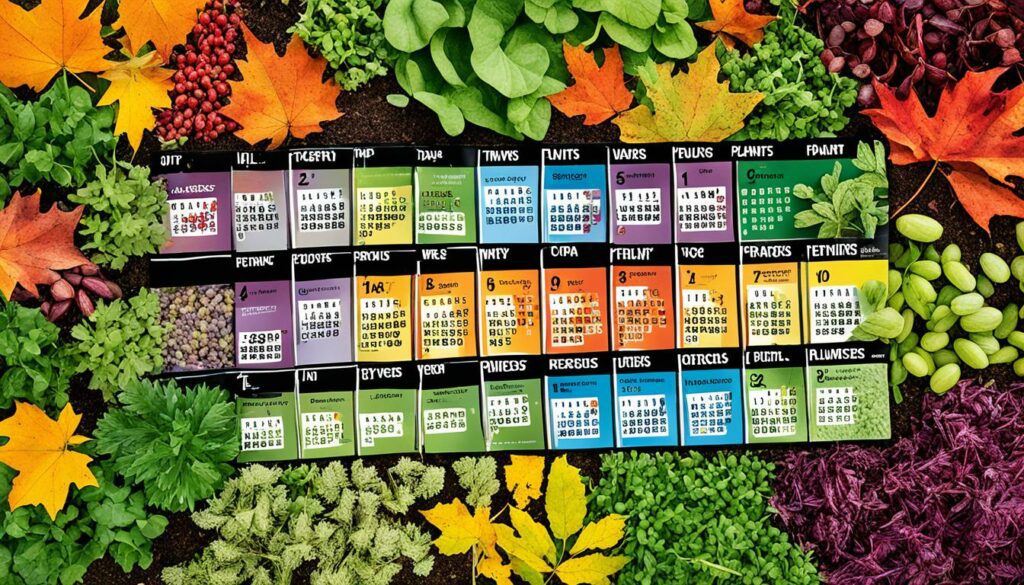
Knowing when your cover crop grows best is crucial. Late summer and autumn are prime times. Crops planted then will cover the soil well before winter, putting nutrients back into the soil.
Using the right tools, like broadcast seeders, helps a lot too. These tools can make planting cover crops more successful.
Keep track of when you plant, how much you plant, and what the weather is like. This info helps you plan better next time. Tools like the Oregon State University Cover Crop Calculator can also tell you how much your cover crops add to the soil.
Getting the soil ready and stopping cover crops right is key to getting the most from them. You’ll learn how to do this well to make the soil better and more productive.
Start by knowing what nutrients the next plants need. Add cover crops to the soil right. This prepares the soil for when you plant the next main crops. Mixing in cover crops helps soil health in many ways, like making it breathe better and getting more nutrients.
Cutting off cover crops at the right time is important. You don’t want them to fight with the new plants. There are different ways to stop cover crops, like letting them die naturally, using machines, or applying chemicals.
| Termination Method | Details |
|---|---|
| Natural Termination | Utilises crops that cannot survive cold winters. |
| Mechanical Termination | Includes mowing, tillage, and roller crimping. |
| Chemical Termination | Involves herbicides like 2,4-D, glyphosate, and Gramaxone. |
The right time to end them is crucial. For example, cut grasses after they’ve made seeds but before autumn. Finish off legumes after they’ve made seed pods. It’s good to end early for the next plants. Ending later can help keep water in the soil.
Some cover crops are harder to stop with chemicals. You might need to treat them differently. Planting technology might also need to change to let you plant the next crops better.
As the seasons change, autumn cover cropping becomes key in garden planning. It ensures your garden is ready for the next planting season. Also, it gives the soil a chance to rest and get stronger. Choosing the right fall cover crops is crucial, based on what your soil needs.
Choosing the right cover crops is vital for crop maintenance. Legumes like crimson clover put nitrogen back into the soil. This reduces the need for extra fertilizers. Winter rye is great for cold places. It starts growing in soil as cold as 34F. Its deep roots, up to 16 inches, improve the soil and stop erosion. Plus, they help keep weeds away.
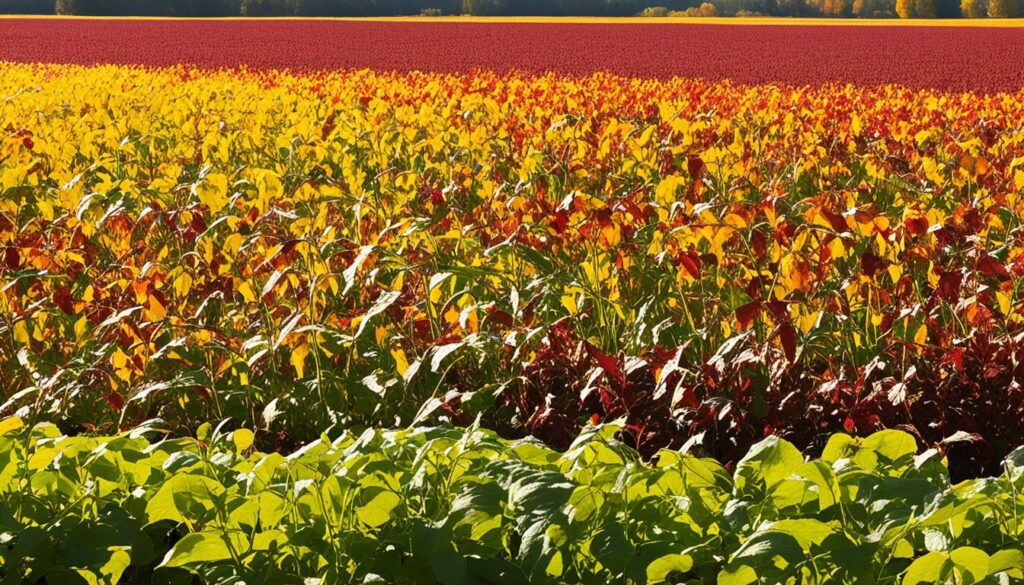
Knowing about the growth habits of chosen crops is key. Oats can grow in the cold and get up to 4 feet tall. They add carbon-rich matter to the soil. This helps with crop maintenance. Winter rye can be 3 to 6 feet tall by spring. It needs to be cut before it seeds to avoid weeds. Sowing at the right time is also crucial.
Keeping the soil active and productive all year takes planning. For small gardens, tillage radishes break up hard soil, making it easier for winter crops to grow. Gardeners like Adam Hill suggest clover and buckwheat. They help fight weeds and enrich the soil.
In conclusion, autumn cover cropping can make your soil and garden healthier. By choosing cover crops carefully, you support your soil in a sustainable way. This benefits your garden throughout the next growing season. It shows the all-round good of this method.
Autumn cover cropping is an important strategy in farming. It offers many benefits like boosting soil health. It also helps with pest and weed control in a sustainable way.
By growing legumes like hairy vetch and Australian winter pea, farms can improve nitrogen levels. Some types can add over 100 lb. of nitrogen per acre until they flower. This is great for plants that need a lot of nitrogen, like corn.
Starting cereal crops early means they’ll have strong roots and capture lots of sunlight. This happens before winter starts, getting the soil ready for the next growing season. When planting cover crops after soybeans, it’s crucial to get the timing right. They should be stopped from growing by the end of April to avoid issues when planting corn.
Choosing the right cover crops depends on what you need. Brassica cover crops, including radish and mustard, break through hard layers in the soil. This makes it better for planting future cash crops. These crops also help use and recycle nutrients, which means less chemical fertilisers are needed.
Autumn cover cropping is a smart move for farmers looking to take care of the land. By doing this, not only does soil health improve, but crop yields get better too. It shows a path to farming that is better for the environment and more sustainable in the long run.
Autumn cover crops make the soil better. They stop weeds and boost the way soil is formed. These crops add nutrients and healthy material for next year’s harvests.
Autumn cover crops help the land in natural ways. They cut down on man-made chemicals, help different plants grow, and keep the soil healthy. This way, farming doesn’t hurt nature.
For autumn, choose grains like rye and oats, legumes such as clover and peas, and plants with wide leaves like buckwheat and mustard. Each type helps the soil in its own special way.
To start, pick the right cover crops for what you want to grow. Then, plant them the best way and take care of them. This makes sure the soil and future crops are healthy.
Winter cover crops keep the soil well over cold months. Ones like winter rye and red clover can handle frost and add good things back into the soil.
Try no-till methods to keep the soil strong. Adding mulch can stop erosion. These ways help keep the whole soil world healthy.
Some cover crops, like legumes, take in nitrogen from the air and put it in the soil. Others, like radishes, find nutrients and make them ready for future plants.
Grains help make the soil loose and not packed. Legumes turn air’s nitrogen into food for the soil and later plants. They are great for soil health.
First, check what your soil needs for the next crop. Then, get it ready for the cover crops. Plan how to end the cover crop’s life so it helps the soil more.
Cover crops with deep roots, like rye grass and clovers, stop the soil from washing away. A lot of plants growing together also protects the ground from erosion.
Plant them right after the summer crops are taken out. Look at your area and when things grow best there. This makes sure your cover crops get a good start.